What is your Product Strategy? Well, YOU NEED A STRATEGY.
When I think about this scene in my head, I can hear the CTO very loudly yelling with our product team.
We had been experimenting with a detailed concrete goal for 2 months and had made loads of progress.
We had learned about what was preventing users from signing up on the site, and it was clear in which direction we should be going. BUT we still had to test our ideas.
This didn’t sit well with the CTO because actually, he didn’t need a strategy, he wanted a concrete plan. He wanted a list of what we were going to build, and when we were going to build it.
He wanted to feel certain about what we were doing when we all came in tomorrow, so he could measure our progress based on the proportion we built. It’s not his fault though. This is the way we were taught to consider Product Strategy.
Most companies fall under the trap of considering Product Strategy as a plan to create certain features and capabilities.
The problem is that when we treat a product strategy as a plan, it’ll always fail. Plans do not account for uncertainty or change.
We need to implement a plan but the plan shouldn’t be “build feature x.” Our plan should be to attain our business goals.
We need to modify from wondering about Product Strategy as something that’s dictated from top to bottom, and instead something that’s uncovered as we learn what is going to help us achieve our objectives.
In this article I will explain product strategy definition, end-to-end process on the framework involved, how to create a great product strategy with some examples, and template, so you can influence others like a ninja.
Product Strategy Definition
Before developing or opting for a product strategy firstly you need to understand what exactly is a product strategy.
Product strategy defines what your product should achieve and, and how it is brought to life through the product road map once it is launched.
Also, this strategy should answer key questions such as who the product will serve (personas), how it will benefit those personas, and what are the company’s goals for the product throughout its lifecycle.
Importance of Product Strategy
- A product strategy draws from the final vision of the product.
- It states where the product will end up.
- By setting a product strategy, you’ll determine the direction of your product efforts.
- The product strategy forms the idea for executing a product roadmap and subsequent product releases.
- The product strategy enables the corporate to specialize in a selected target market and has set, rather than trying to be everything to everyone.
Product Strategy Types
Cost Strategy
A cost strategy focuses on creating the most effective product for the bottom price.
It assesses the resources being employed and determines where the money is saved during production.
This is an effective strategy for low-effort purchases such as household cleaning items.
So for these industries, if you’ll create a product that undercuts your competitors’ price point, it’ll be a sure favorite for your customer base.
Differentiation Strategy
Price isn’t the main criterion when it comes to differentiating your product. There are many other ways in which you’ll make it stand out in your industry.
So, maybe it’s a luxury product that uses world-class materials. or, its ground-breaking features that revolutionize space.
Whichever it should be, this approach focuses on giving your product a personality that creates it memorable and pleasant to your customers.
Focus Strategy
If your company contains a large customer base, maybe you would like to make a product that appeals to at least one specific buyer persona.
This is an efficient strategy because it targets the requirements of a particular group of individuals and creates a customized solution for them.
This is a great idea to gain brand loyalty when acquiring new customers.
Product Strategy Planning
Strategic product planning is the process of defining how you’ll achieve your vision.
By working backward from your required end state, you’ll set goals and initiatives to guide the implementation of your strategy and a timeline to attain them.
That timeline is usually stated as a product roadmap.
It is essential to have a unified plan that ties company-level objectives to the products. This ensures alignment between your overarching goals and the day-to-day work, which is often referred to as the “execution.”
Product Strategy Roadmap
Your product roadmap doesn’t exist in a vacuum. Your vision should be long-term, and the product strategy should focus on achieving it.
A product roadmap is a visual tool that will visually communicate how to anyone who’s invested in the product (your team, your stakeholders, and, in some cases, your customers).
We generally think of the roadmap as a statement of intent rather than an unchangeable map.
This means you’ve got to be ready to forecast how the product might grow, yet also be prepared for the inevitable changes that arise as your product grows and you learn more about your market and your customers.
A strategic product roadmap depicts your strategy, vision and guides the execution of the strategy.
It also aligns internal stakeholders, communicates short and long-term progress of development, and shares the product strategy with external stakeholders.
Product Strategy Framework/Elements
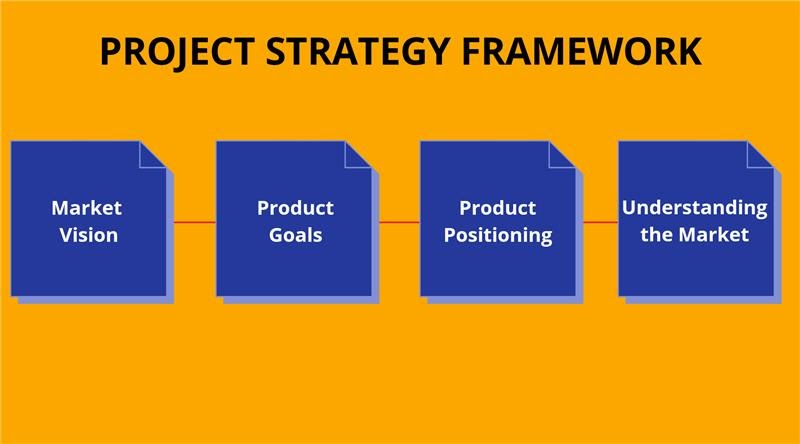
So, next comes is the product strategy framework. Creating a framework is not rocket science, you just need to understand the elements of product strategy.
It is composed of mainly four core elements: market vision, product goals, product positioning, and understanding the market.
Vision
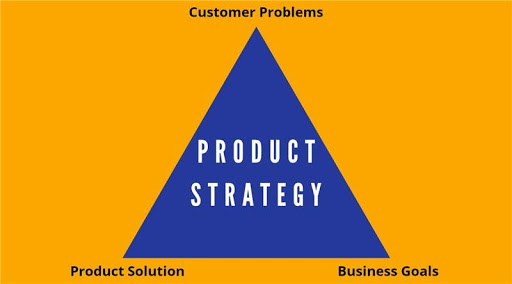
Product vision represents the essence of your product. It should answer these questions as who exactly are your customers? What are the problems you are helping them solve? What opportunities and threats do you face?
So, your company should opt for a vision to address your customer needs relative to the competition in the market.
Product Goals
There has to be some sort of product goal to your efforts with a product strategy.
Just prepare for goals smartly. Here what I mean is that these should be specific, measurable, attainable, relevant, and time-based.
Therefore, your product should have unique features, presenting benefits that you are offering to the customers.
Also, don’t compromise with quality. Keep it consistent and this will help in strengthening your company’s reputation.
Hence, make the product goals clear-cut with an essence of urgency behind them.
Product Positioning
Now, this is the strategic exercise that is done before a product launch. It helps define where your product fits in the marketplace and the unique benefits you provide.
Strong positioning supports your marketing strategy, brand storytelling, and all content developed for customers.
So for Netflix, it would like something like this:
For millennials who want on-demand entertainment, Netflix is an online subscription TV service that works seamlessly. Unlike HBO or HULU, Netflix releases original content for binge-watching.
Understanding Market

Last but not the least, you need to deeply understand your customers and what they need to build a product they will love.
So, build a customer persona documenting their likes and dislikes, professional aspirations, and challenges.
This will help you in building features that will solve their problems.
Also, analyze the competition in the market. This will help you to know where you fit within the broader market and what opportunities exist.
Marketing Mix
The product is the most important element of the marketing mix. If you have decided on a market segment to target, then product design plays a crucial role.
This is because a change in the product brings a change in all the other elements of the marketing mix.
Be it a service or a product, the marketing mix majorly depends on the product for other aspects like promotions, place, and price.
In essence, the core aspects of the product and its contribution to the marketing mix are decided in this step.
Product Strategy Development

You must be thinking of the track on how you can build an effective product strategy. I will also explain the uber taxi example with the product strategy behind their success.
Idea Validation Phase
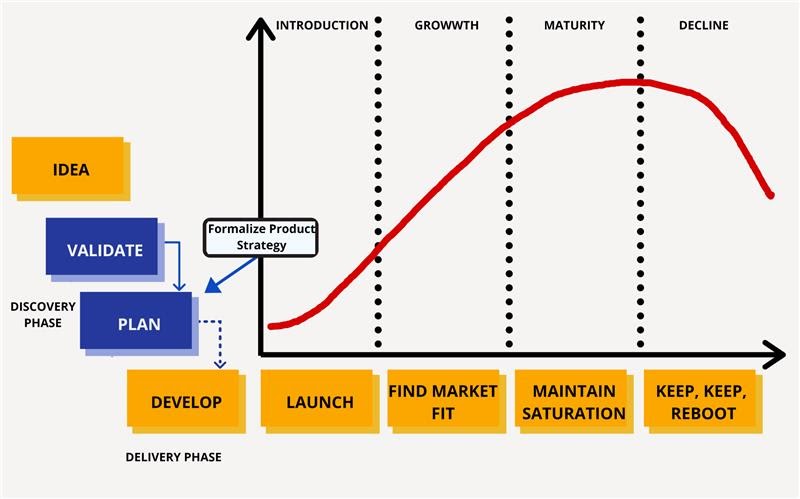
Technically, the moment you’ve decided to validate an idea, you’ve embarked on the journey to build your product strategy.
Formalizing the product strategy is best done after the idea validation phase and before you create your product roadmap.
3 Things To Include In Your Product Strategy
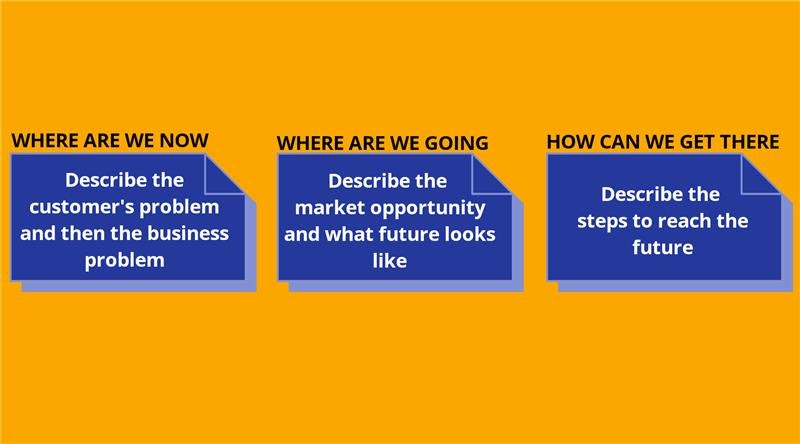
Your product strategy should define three core areas: “The Now”, “The Future”, and “How we get there”.
Where we are now- This will describe the current state as in current business goals, problems, technology, and market landscape.
Where are we going – You need to paint a picture of what the future looks like. This should include some information as the vision of your product, revenue opportunity, product differentiation, and key metrics.
How do we get there – Lastly, you should include some information on milestones, the company’s goals and initiatives, risks involved, and resource requirements.
Elevator Pitch (Discovery Phase)
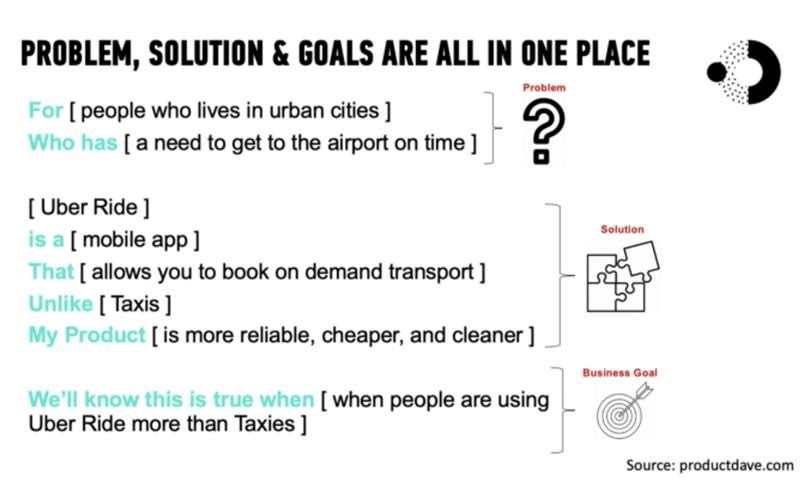
Start with a simple Elevator pitch to advance into the discovery phase.
Here is an example of the Elevator pitch using Uber:
Other tools available are The Product Vision Board or Product Strategy Canvas.
Delivery Phase
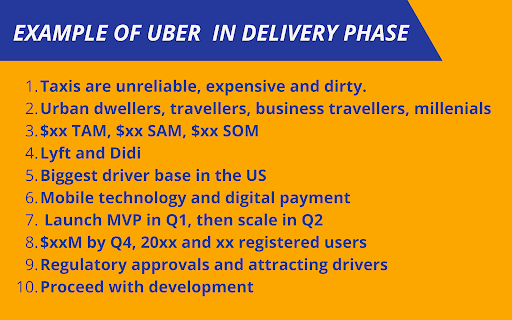
In this stage, you’ll need to start involving external stakeholders in this journey. The questions you need to answer will be much broader.
The Opportunity Assessment by Marty Cagen is a great tool to analyze and opt for a broader product strategy.
- Exactly what problem will this solve? (value proposition).
- For whom do we solve that problem? (target market).
- How big is the opportunity? (market size).
- What alternatives are out there? (competitive landscape).
- Why are we best suited to pursue this? (our differentiator).
- Why now? (market window).
- How will we get this product to the market? (go-to-market product strategy).
- How will we measure success or make money from this product? (metrics/revenue strategy).
- What factors are critical to success? (solution requirements).
- Given the above, what’s the recommendation? (go or no-go).
Start with the above questions, and add or remove questions that are relevant to your company. Like I have mentioned one for the Uber app.
Feedback
Once you have built the first version of your strategy, seek feedback from your team. Store your strategy in a place that can be freely reviewed and collaborated in Google Slides or a Share Drive.
Whenever possible, send out the link to the file instead of attaching it to an email. Sending out links allows you to control different versions much easier.
Product Strategy Template
Roman Pichler’s product strategy canvas is a neat tool for developing a solid definition of who your target audience is, what their problems are, and how you can turn those problems into actionable tasks for the team to work on.
Use the template as shown in the chart. Use data in surroundings to establish a one-two sentence market vision. Once that’s complete, establish your product goals.
Product Goals
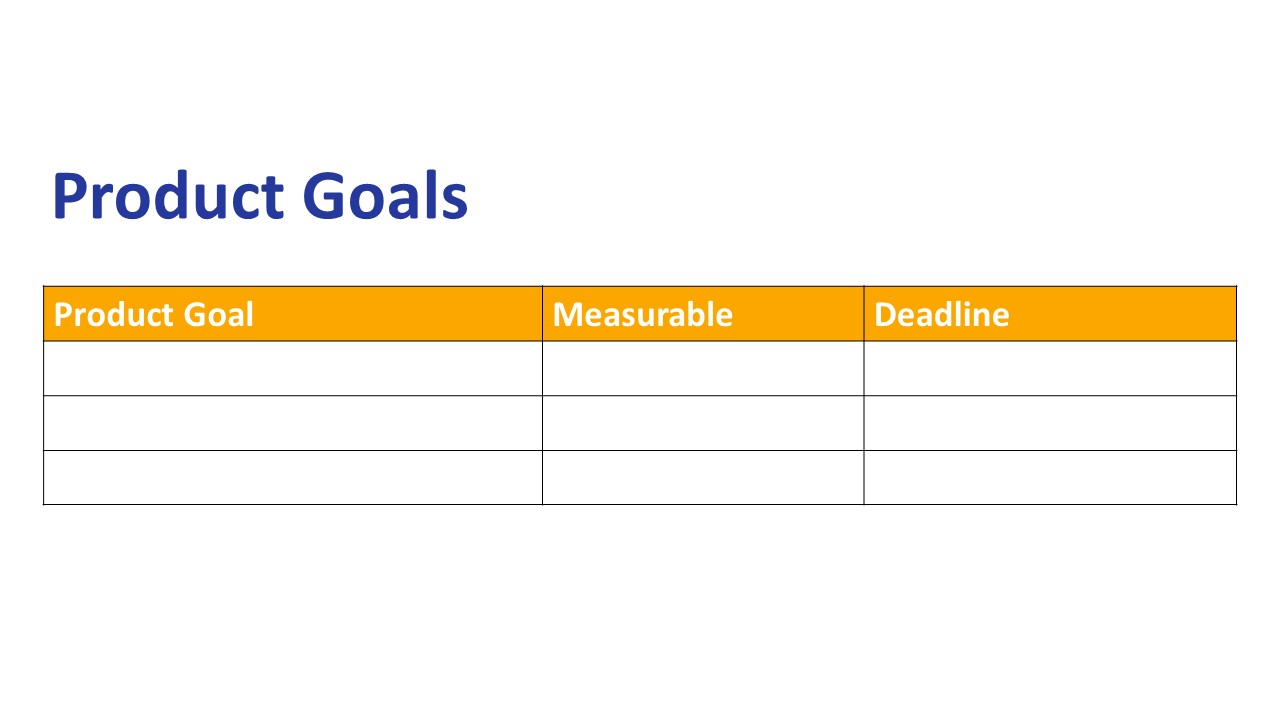
In the first column add your product goal. Then in the middle column as the metric or method, you will use to measure its success. The thirst step is to add the goal’s deadline to the final column on the right.
Product Initiatives
In the first column add your product initiative and then add its deadline in the right column.

Some More Successful Product Strategy Example
Do you know that Facebook was launched in 2004? MySpace was the dominant social media site at the time. So how did Facebook take over?
One important thing I like you to know is that Facebook adopted a market penetration growth strategy.
Facebook began in the Harvard dorm room of Mark Zuckerberg. Once Facebook gained traction at Harvard, it gradually expanded to other colleges. After Facebook spread to colleges, it opened up to non-students.
Hence, Facebook mainly focussed on adjusting the product to the needs of each new customer segment.
Apple
In 1984, Apple released the Macintosh 12K8 — the first iteration of what would go on to become the world’s most popular brand of a personal computer.
Its market vision revolved around giving the average person access to straightforward, aesthetically appealing personal computing.
Then, Apple set a series of measurable, time-oriented goals for the Macintosh — specifically when it came to sales. Apple estimated that the Mac would sell 50,000 units in its first 100 days. This target was achieved with relative ease.
Apple released the original Macintosh with the tagline “The computer for the rest of us.” The original Mac was designed, positioned, and marketed as a machine that would enhance the future of personal computing.
That was Macintosh’s product initiative. And for what it’s worth, Apple nailed it.
Dollar Shave Club
When Dollar Shave Club launched its razor business in 2012, Gillette had a commanding share of about 70% of the U.S. market.
Meanwhile, Dollar Shave Club’s growth prompted Unilever to buy it for $1 billion. How did Dollar Shave Club defy a much larger competitor?
The key to Dollar Shave Club’s success is that it could offer a lower-priced alternative to the leader by selling directly to the consumer.
It used the internet to employ a direct-to-consumer business model that allowed it to sell razors for as little as a dollar.
So, Dollar Shave Club worked with manufacturers in Asia to produce razors, eliminating any markup from a middle man. These cost savings could be passed on to consumers who flocked to its low-cost offering.
Product Scope Strategy
The product-scope strategy deals with the outlook of the product mix of a corporation (i.e., the number of product lines and items in each line that the corporation may offer).
The product-scope strategy is decided by referring to the business unit mission.
Presumably, the mission defines what kind of business it is aiming to be, which helps in selecting the products and services that are to become a section of the product mix.
The product-scope strategy should be finalized after a careful review of the facts of the business as it includes long-term commitment.
Additionally, the strategy must be evaluated from time to time to make any changes called for. This is because of shifts in the environment.
For instance, Eastman Kodak Company’s decision to enter the instant photography market in the early 1970s. Later, Polaroid bought negatives for its films, worth $50 million, from Kodak.
In 1969, Polaroid built its negative plant. This implies that Kodak would lose $50 million of Polaroid’s business and be left with idle machinery that had been dedicated to Polaroid’s needs.
Moreover, by designing its film, Polaroid could lower its costs; if it cut prices, instant photography might become more competitive with Kodak’s business.
Product Strategy Branding
A successful product strategy branding develops brand awareness and identity that sets your products apart from the countless others solely based on the brand name.
So, a well-designed strategy reminds current and potential customers that they should purchase your product over others with similar characteristics.
The brand name urges a customer to buy a product based on his emotional ties, not on quality or price; although quality and price are vital to the brand life span.
So, create a crucial brand identity by writing and implementing a product and brand strategy.
Summary
The power of a product strategy comes from what you exclude. as well as what you define.
Regardless of which tools you use, all strategy revolves around answering the following three questions. These are Where are we now? Where are we going? and How do we get there?
Once you have formulated a clear product strategy, you’ll have a north star to guide your product roadmap and influence others like a Product Master.








